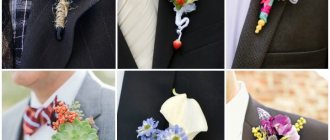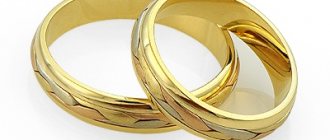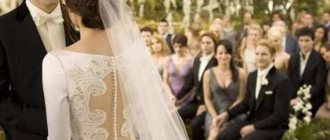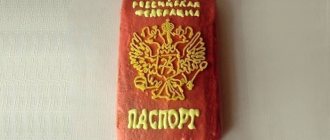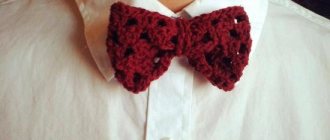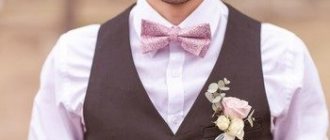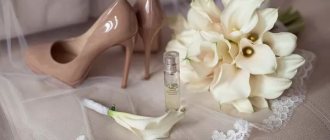When choosing a suit for a wedding ceremony, men are often interested in what a boutonniere for the groom is and where it is attached. Many people do not know that this accessory for decorating the lapel of a jacket should be in harmony with the bride’s bouquet. If you want to look irresistible at your own wedding, you should choose in advance a suitable decoration from flowers, buds or leaves.
The boutonniere for the groom should be in harmony with the bouquet.
Boutonniere made of fresh flowers
You can make a boutonniere with your own hands from fresh flowers by purchasing the necessary plants and small items at the nearest floristry salon.
Materials and tools:
- eustoma;
- gypsophila;
- heather;
- fern;
- green wire;
- floral tape;
- scissors.
Time: 20-30 minutes.
Step-by-step instruction:
- Thread a wire through the base of the bud to strengthen the delicate stem of the eustoma.
- Place the wire in the middle of the bud.
- Place the wire down along the stem.
- Wrap the stem and wire with floral tape, giving it a neat look, and add heather to it.
- Cut the heather stem to half and attach it to the eustoma with floral tape.
- Add a fern to the composition.
- Wrap ribbon around the overall stem of the arrangement and trim the fern stem.
- Make one out of three separate compositions - this will be the boutonniere for the groom.
- Wrap the common stem of the boutonniere with floral tape and trim to the desired length (usually about 5 cm).
- This is what your creation will look like! Now you know how to make a boutonniere from fresh flowers, so you can safely get down to business!
Tip: Blue eustoma flowers don't fit into your wedding palette? Then a bright poppy boutonniere might be right for you, which is also easy to make yourself!
Step-by-step master class
Having decided on the materials from which the boutonniere will be made, you can begin to work. But without proper experience, a self-made product may not be accurate enough. The master class will help solve this problem. There are many original ways to create a boutonniere with your own hands on the Internet. Before you get started, you need to prepare the following tools:
- the material from which the accessory will be created;
- pins for fixing decorative elements and attaching boutonnieres to clothes;
- scissors or pruning shears;
- floral wire;
- wire cutters
The list of required equipment can be supplemented depending on the accessory being manufactured.
For feather guests
An excellent option for making a boutonniere for guests would be to use decorative or natural feathers of different colors. To create a decoration, you must adhere to the following algorithm of actions:
- Gather all the feathers into a bun, forming a neat bouquet.
- Add other decorative elements (ribbons, beads, mesh) to the overall composition.
- Securely tie the base of the accessory with a ribbon of a suitable color and secure it with glue or a pin.
At the end, you need to fix the wedding attribute on the clothes. This accessory is easy to assemble and very inexpensive. The materials can be purchased at any craft store.
Roses for the bridesmaids
Even inexperienced needlewomen can make flower boutonnieres for bridesmaids with their own hands:
- Stretch the floral wire through the base of the bud and position it so that even parts of the edges remain on both sides.
- The wire must be pressed to the stem and wrapped with a ribbon of a suitable color.
- Add leaves or other elements to the bud, which are pressed against the stem and wrapped with fabric tape.
- After completing the composition, you need to cut off most of the length of the stem and leave 1-3 cm.
Finally, you need to secure the ribbon with a pin on the back of the accessory and use it to attach the decoration to the outfit.
Traditionally, a boutonniere is an accessory that consists of one bud; this option is made for the bridesmaid. The classic attribute is made from roses of a delicate shade.
What a boutonniere should look like: simple rules
What is a boutonniere for a wedding? This is a flower on the lapel of the groom’s jacket - a single flower or a laconic composition of small inflorescences. Translated from French, the term means “flower in the buttonhole”; initially it was customary to wear just one flower. Modern creative designers, along with the classic version, also offer beautiful wedding boutonnieres in the form of small bouquets or one large flower framed by small ones. The boutonniere brooch looks very elegant and self-sufficient, without requiring additional accessories in the suit.
Photo of a wedding boutonniere
A man's boutonniere must be in harmony with the cut and color of the suit or shirt, as well as accessories, in particular with a tie
It stands out against the background of a jacket or shirt, complementing the image, but at the same time, you should not choose an option that is too flashy, which will distract complete attention.
Nowadays, the wedding boutonniere is acquiring a broader concept - such small bouquets are usually used to complement the interior, wedding table, attach to the handles of cars, and also decorate guests’ outfits. A women's boutonniere as a bracelet looks sophisticated and festive on the wrist of the bride and bridesmaids. Boutonnieres for bridesmaids should be less flashy, but certainly in the same style. You can also make a hoop boutonniere - with such compositions you can decorate your hair or dress.
Types of boutonnieres
Boutonnieres made from fresh flowers look luxurious and rich. And although such compositions have the disadvantage that lies in their fragility and fragility of pristine beauty, they look very romantic and elegant. To extend the life of flowers, their stems are placed in a small capsule with a moisture-retaining solution.
Very often young people prefer to create bouquets using artificial materials. They can be made of polymer clay, satin ribbons, fabrics, foamiran, and complemented with beads, rhinestones and seed beads. You can find completely creative boutonnieres, where in addition to flowers, berries, cones, pine needles, feathers, and even small Lego elements are used.
Photo of a wedding boutonniere made of satin ribbons
In modern wedding decorations, it is common to follow different styles: classic, vintage, eco, etc. Of course, the boutonniere is made in accordance with the chosen theme. For example, for weddings in rustic or country style, simple wildflowers, ears of corn, berries, and pine cones are used, which are played with natural materials: wood, burlap. Lovers of glamor and creativity can make a boutonniere of completely unexpected abstract designs using feathers, rhinestones, original rare inflorescences and herbs.
The boutonniere can be decorated for a certain season of the year. For example, an autumn boutonniere can be made in bright orange-yellow tones with a combination of dry herbarium leaves, tea roses and chamelacium, or using rowan berries. The winter one can be made from a sprig of spruce or thuja with a large white rose in the center of the composition, or recreated from large transparent and white crystals, a white bow, decorated with beads, pearls and sparkles.
Photo of an autumn wedding boutonniere
Boutonniere on the bride's hand
Previously, compositions were attached only to men, but from the 20th century they began to decorate the hands of ladies.
The bouquet should not overload the girl’s hand and emphasize the style of the wedding. It should include one large flower or several small ones.
Combinations of flowers, ribbons and greenery will emphasize the elegance and individuality of the girl.
You can also purchase masterpieces made from polymer clay for the newlywed’s hand, which will look no worse than a living bouquet.
And compositions made from ribbons will look no less elegant on the hand, and during the wedding their appearance will not deteriorate, and the bride will also have an accessory as a keepsake.
Types of boutonnieres
This stylish detail of the groom’s image can consist of either a single flower or be an entire floral masterpiece, complemented by feathers, twigs, rhinestones and other decor.
The size of the accessory should not exceed 10 cm - this is an important and inviolable rule of wedding etiquette.
Traditionally, there are several of the most popular varieties of this decoration, made from:
- living plants;
- artificial flowers;
- fabric or satin ribbons;
- polymer clay;
- all kinds of decorative elements;
- foamiran.
Boutonnieres differ in style, for example:
- For a ceremony in the rustic style, a composition made of coarse burlap, complemented by twigs, bright feathers, imitations of deer antlers painted in silver, and more is perfect.
- Boutonnieres in the Ukrainian style can be assembled from ears of wheat, bright poppies, and sunny sunflowers.
- The lavender decoration looks very gentle and touching - ideal for a wedding in the Provence style.
- A crocheted boutonniere decorated with delicate details in vanilla or cream tones, with curved lines and curls - just right for a shabby chic ceremony.
A new trend in wedding fashion is conceptual decoration in a boutonniere, which successfully replaces flowers and fits favorably into the overall idea and style of the event. For example:
Boutonniere in the shape of your favorite comic book character;
An exquisite shell, a playful anchor or a delicate starfish are excellent options for a men's decorative accessory for a nautical wedding theme.
A symbolic decoration for the newlywed’s jacket buttonhole will be the “key to the bride’s heart,” decorated with plants, ribbons or feathers.
The “pocket” decoration of the groom’s suit can be exclusive bouquets of buttons - which looks unusual and extremely interesting.
Guests will also certainly be surprised by a composition in the form of a flattened cone, an original pendant in the shape of an antique clock, “newspaper” flowers or tree bark in the decoration of a boutonniere.
From fresh flowers
If you want to decorate the groom's outfit with bouquets of flowers, it is recommended:
- Use plants that are not too fancy, then the likelihood that the composition will remain fresh and presentable until the end of the wedding evening will be many times higher.
- The flower should not have a strong aroma, otherwise the groom will be guaranteed headaches and irritation from such “neighborhood” throughout the whole day.
- You should not take plants with a large amount of pollen - when it falls off, it will leave unpleasant stains on clothes.
The most popular representatives of the flora for making boutonnieres:
- roses;
- peonies;
- succulents;
- wildflowers;
- anemones;
- lavender.
Made from artificial flowers
A boutonniere made from artificial flowers has a number of advantages:
- this is the best option for winter weddings, when temperature changes are harmful to plants;
- such a mini bouquet of artificial flowers will look perfect both at the beginning and at the end of the ceremony;
- the choice of flowers, inflorescences and other plant elements is simply huge.
From fabric
Fabric arrangements are surprisingly back on trend, thanks to popular wedding designer and florist Laurie Cinotto. She produces amazing boutonnieres, which are distinguished by their simplicity of execution and the availability of the materials used. Her creations inspire and inspire.
Boutonnieres made using the kanzashi technique still remain relevant. Products made from satin ribbons look cute and delicate, and do not require significant material costs.
If the newlyweds decided that the groom’s suit should be decorated with a floral arrangement made specifically from fabric, then there are many variations of materials for its manufacture: silk, satin, lace, tulle, chiffon, velvet, crepe de Chine. You can choose matte or glossy, plain or patterned, in muted tones or incredibly bright shades of fabric, the main thing is not to forget that the boutonniere should be a harmonious addition to the groom’s image, and not a bright and defiant detail of the suit.
From polymer clay or cold porcelain
Today, ceramic floristry has reached the wedding industry. It is not surprising, because compositions made from polymer clay, which is often called cold porcelain, are real works of art. This plastic and pliable material allows you to successfully work out all the smallest details and achieve stunning similarities between the flowers in the boutonniere and living plants. And the special properties of polymer clay also make them extremely durable: such a “bouquet” will be kept for many years as a family talisman.
Bouquet of snow-white callas
The first master class presents you with step-by-step instructions for making a Kanzashi calla flower from satin ribbons, which can easily be assembled into a small bouquet.
To work, you need to prepare:
- satin ribbons in several shades: white (five centimeters wide) and yellow (two and a half centimeters);
- scissors;
- monofilament;
- a needle;
- lighter.
The first stage of the master class is to prepare blanks for calla kanzashi. To do this, take a light tape and cut it into pieces about ten centimeters long, yellow - about seven cm. Be sure to singe all the cut edges with a lighter so that the tape does not crumble.
Fold the edges and gather them with a thread.
Next, you need to fold the corner for the calla stamen and twist it.
As a result, after twisting you will form a stamen, as in the photo. Now, it needs to be fixed and stitched. This action will help to thoroughly consolidate this element. Another way to create a stamen is to make it from beads.
At the next stage, the stamen is inserted into the calla petal and sewn on.
After this, the thread of the petal is tightened near the stamen.
Along the upper edge of the calla lily, you need to lightly walk with the flame and press a little.
Thus, as a result of a simple procedure, you will get a calla flower using the kanzashi technique. You can use this product at your own discretion. Either create an original flower arrangement for a picture, or attach a special mount and wear it like a jewelry in the form of a hairpin.
Boutonniere for the groom - tips and much more
Are you dreaming of the perfect wedding? But a perfect holiday requires maximum effort. You need to carefully consider the menu, invitations for guests, and attire for the newlyweds where the celebration will take place. The boutonniere for the groom deserves special attention
To successfully choose this accessory, you need to take into account the style of the bride’s outfit and many other subtleties.
Signs associated with the groom's boutonniere:
- A huge number of superstitions are associated with a wedding, and some signs affect the boutonniere for the groom:
- The flower must be attached on the left side, where the heart is located.
- Both young and young will need a safety pin, which is attached to clothing “head down” (to protect against the evil eye). A woman can attach it anywhere on the dress (only inside), and a man can attach an artificial or living flower to her. The most important thing is that the pin is not visible to strangers.
- While removing the veil from the betrothed, a couple of “young” guests are present - the girl puts on part of the young dress, and the man wears the groom’s boutonniere. If lovers are chosen for such a competition, they will soon get married.
- Young people should not part with either their veil or boutonniere. Therefore, before the start of the celebration, you will need to order an alternative flower and an attribute such as a boutonniere. These two things should be kept throughout the life of the family and act as an heirloom. For example, if a child in the family falls ill, they cover him with a veil or hang it over the bed to protect the baby from the evil eye.
When should the groom wear a boutonniere?
In almost all situations, the bride puts a boutonniere on the groom after the ransom has passed. The groom gives a bouquet, and the bride attaches a flower to her jacket as a sign of love. You can change this ancient tradition a little, which came to us from Rome. Place a boutonniere in the bride's bouquet so that she can give her future husband a flower from her bouquet, as they did before.
Bouquet with cotton: features, photos and design of compositions
How did “non-flower material” come to be used in creating wedding bouquets? The answer is simple: cotton (also known as cottonseed) is the most common plant fiber. It is what covers the seeds of a plant called cotton. Therefore, in its original form, cotton is a dried flower, ideal for creating a bridal bouquet.
What colors does cotton go with?
In order for the bride’s main floral attribute to be harmonious and complement her image favorably, it is necessary to carefully consider all its components. Cotton, as an element of a wedding bouquet, requires careful handling. It is best to entrust the composition to a professional. Let's, together with the Svadebka.ws portal, analyze which colors cotton looks most advantageous with:
- Ranunculus (in other words, garden buttercups) are very delicate flowers, and when combined with cotton they will look even more sophisticated. A composition of these seemingly delicate flowers can be unexpectedly bright. Choose red ranunculi, roses, hypericum berries, combining with cotton to create a colorful bouquet. The result will definitely surprise you.
- A bridal bouquet of peony roses combined with lush clouds of cotton will give the bride a romantic mood.
- Lavender with cotton is a perfect match for the Provence or rustic style. An ideal choice for a purple wedding, shabby chic style, as well as a forest celebration. A bouquet with cotton and lavender is suitable for brides who are not afraid of experiments. The wedding composition will add notes of sensuality, sophistication and inspiration to the bride’s image.
- Lagurus. You may not have heard this name before, but the elegant plant, also known as haretail, goes well with cotton. Svadebka.ws invites you to look at the photos of stunning wedding bouquets with cotton and lagurus below.
- A bridal bouquet made of anemones and cotton will create a catchy accent in the bride's image thanks to a wide range of shades.
- Hydrangea. With her participation, the flower arrangement acquires real French charm. A wide range of colors and shades allows florists to create true masterpieces. We offer an interesting version of a cotton wedding bouquet for the bride with a fabulous combination of hydrangea, eustoma (lisianthus) and eucalyptus branches.
Interesting: Cotton comes not only in the usual white color. At the stage of opening the box, it changes its shade from yellow to brown.
What else can you combine cotton with in a bouquet?
In addition to the main flowers, the bride’s bouquet needs to choose a harmonious decor in the form of additional materials. Cotton combines most successfully with the following natural design elements:
- Succulents perfectly convey the special atmosphere of a wedding in styles such as vintage, rustic, shabby chic.
- Cones are a godsend for decorating a winter bridal bouquet.
- Fir branches are an excellent type of themed “winter” greenery.
- Burlap - allows you to express the special features of some wedding styles (rustic, eco, Provence, etc.).
- Berries – hypericum, viburnum, red rowan.
- Small apples must be the same in color and size.
- Fennel.
From artificial decor you should pay attention to:
- crystals;
- snowflakes;
- satin ribbons;
- lace;
- pearl;
- rhinestones;
- pieces of mother of pearl.
Boutonniere for the groom with cotton
A great idea to maintain style cohesion is to use cotton in the groom's boutonniere. This accessory looks quite extraordinary. And if the celebration is planned in winter, you win doubly, because cotton does not lose its original appearance even in severe frosts. Interesting options for boutonnieres with cotton to match the style with the bride’s bouquet are shown in the photo below.
Important: The advantage of resistance to temperature changes becomes decisive when choosing floral arrangements with cotton for brides, because thanks to this property the question does not arise of what to do with the bouquet after the wedding
Agree that creating a bouquet of roses is a common thing, which cannot be said about wedding arrangements with cotton. We keep up with the times and change established standards together with our portal! Choose only the best!
- 21 photos
How to make it yourself
Boutonnieres for witnesses from artificial flowers can be prepared independently in advance, but if you plan to use fresh inflorescences in the composition, such decorations are made several hours before the start of the event. Want to get everything done the night before your wedding? You can preserve the freshness of flowers by placing the finished boutonnieres in the refrigerator, in a special bag with small slits. It is advisable to practice beforehand, otherwise you risk being left without boutonnieres for witnesses and guests.
Fresh flowers must be fresh. At the same time, it is better to give preference to half-opened buds. Before work, put them in water for two hours: this will allow them to be saturated and not need additional moisture. In addition to flowers you will need:
- tape for taping;
- floral wire (about 10 centimeters);
- pins for fastening;
- glue;
- all kinds of decorative elements (twigs, hard berries, blades of grass, spikelets, feathers, rhinestones, beads, ribbons, lace, leaves or shells).
Let's move on to assembly. A women's boutonniere for the wrist is made according to the principle of a wreath. If we are talking about a classic design, you will have to tinker a little. The stem is cut obliquely and pierced with floral wire. To string leaves onto it, the wire is carefully threaded along the central veins. Each element of the boutonniere is wrapped tightly and without breaks with ribbon. This will help retain moisture in the stem.
When all the components are prepared, start assembling the composition. The central flower is the main one in the boutonniere, so the remaining decorative elements are placed in one of three options of your choice.
After this, the flower stems are tightly twisted with taping tape, the excess wire is cut off, and a pin is sewn to the finished boutonniere.
Handmade boutonnieres will be even more valuable to their lucky owners, because you put your love and care into making these cute decorations. Just a little bit of hard work, patience and imagination will allow you to create a piece of jewelry that will remain as a keepsake for your loved ones.
Features of wedding accessories
A girl’s chic festive dress and a young man’s formal suit are not all that is needed to create ideal images. Integral accessories are the bride's bouquet and the groom's boutonniere. Young people often have the opportunity to order them as a set. Such a bouquet and boutonniere are made in the same style. To create them, identical flowers, beads or ribbons are used. The unity of color and shape suggests that the lovers have something in common.
Since decorations made from fresh flowers are most often chosen for a wedding, the bouquet and boutonniere are made using them. Groomsmen and bridesmaids can also use similar details in their outfits.
The boutonnieres of the witnesses are slightly smaller than those of the groom, but they are created in the same style. For girls, in addition to dresses of the same color, bracelets are offered in the same design as the bride's bouquet. A single style is maintained both for decorative floral inserts in the bride’s hairstyle and for table decoration.
The same ribbons (usually satin) are often used for the bouquet and boutonniere. They wrap the base of the bouquet. However, no less stylish would be the option of wrapping flowers with burlap rope or twine.
Following tradition, the groom gives the bouquet after the “ransom”. Meanwhile, the bride attaches a boutonniere to her chosen one’s suit, thereby showing her love and tenderness. It turns out especially touching if the accessories are made by the hands of the couple themselves.
Features of callas in a bride's bouquet
Calla lilies were originally used in bouquets in America.
Thanks to their beauty, they quickly gained popularity around the world. A flower growing in southern Africa captivated officers from Britain in ancient times. They brought the sprouts home and began to distribute this plant.
The buds are unique in their aroma. On the one hand, it is barely perceptible, but on the other hand, it is an interesting contrasting combination of taste. Vanilla and anise come together.
A wedding bouquet with calla lilies will complement any look. Callas, like no other, are ideal for a wedding composition. The plant tolerates both heat and cold perfectly. The bouquet can last a little more than two weeks in ordinary cool water. It does not require any special care.
If you want to get an exotic flower, then know that it blooms from January to June. Therefore, it is during this period of time that you will be able to buy calla lilies.
Florists highlight the positive aspects inherent in an exotic plant:
- A formal look that pairs perfectly with other colors. Callas add elegance and sophistication to the look. And by combining it with plants of other varieties you can get quite interesting combinations.
- They are not picky about care - all that is required is to place them in clean, cool water.
- Since flowering occurs in the winter season, we can say that the African flower is ideal for severe frosts. A long photo shoot on the street will not spoil the original appearance of the bouquet.
- A rich palette of colors allows you to choose absolutely any shade. It can be either delicate pink, innocent white, or bright purple.
How to attach a boutonniere to a jacket: basic mistakes
Let's look at what not to do when attaching this element:
- Boutonniere in your pocket. This arrangement of this element is unacceptable. This spoils the appearance and is also inconvenient, as it may fall out during the celebration.
- The pin is too weak. A weak fastening element will not withstand the required weight, and the groom will simply lose the flower. Choose a medium-sized pin, and for large bouquets use two.
- Hidden stems. A boutonniere represents more than just flower heads. This is a single element with a bud and stems - a kind of miniature bouquet. Don't try to hide the stems in your pocket or under your lapel.
Now you will definitely not make common mistakes.
More about boutonnieres
The word "boutonniere" comes from the French "boutonniere", which means "buttonhole flower". This accessory (in the traditional sense) is actually a miniature flower arrangement inserted into the buttonhole of a jacket.
Boutonnieres can be made from various materials.
Depending on this, the following types can be distinguished:
- Natural (from fresh flowers);
- Unnatural (made from fabric, ribbons, paper or other materials);
- Boutonnieres made of dried flowers.
Let's look at each type in a little more detail.
Flower boutonnieres
Fresh flowers are a traditional material for wedding boutonnieres, because they emphasize tenderness and touching, but at the same time the solemnity of the event.
What flowers to choose?
- Field. Chamomiles, lavender or other wildflowers are great for a summer celebration with an outdoor reception, as well as for a rustic wedding.
- Peonies. These beautiful flowers are best used during their blooming season, spring.
- Roses. The classic choice for a boutonniere is a rose. You can “play” with its color and make a stylish accessory for a wedding of any style.
- Irises. Flowers, symbolizing masculinity and valor, will complement a wedding suit in blue and lilac tones.
- Tulips. Another great option for a fresh spring wedding.
- Calla lilies. Graceful flowers go well with any outfit. Purple looks incredibly elegant, orange is suitable for a bright autumn wedding, and yellow is suitable for a spring or summer wedding.
- Herbaceous anemones. Elegant greenery can serve as a harmonious complement to any other flowers.
- Sculents. Plants with thick, succulent stems will add originality and tenderness to the boutonniere and will go well with light outfits at an outdoor wedding.
Unnatural boutonnieres
Modern newlyweds are increasingly choosing boutonnieres made from artificial materials, fearing that the flowers will wither by the end of the celebration. The “competitors” of fresh flowers are:
- artificial flowers;
- ribbons;
- fabrics;
- buttons;
- polymer clay;
- feathers;
- fragments of comic books or Lego figures.
Dried flower boutonnieres
Dried flowers - dried plants - look very attractive and do not change their appearance. You should be careful when choosing dried flowers, because some dried flowers become very fragile. Boutonnieres made from dried flowers are just gaining popularity and look very original.
Additional Tips
When choosing a boutonniere, it is important to consider that fresh flowers quickly lose their attractiveness. To prevent the rose or chrysanthemum in your buttonhole from wilting in the first hour of the wedding, you need to treat the cut with wax or place the bud in a miniature vase. It is better to prepare 2 decorations, replacing the wilted flower after the gala event at the registry office with a brooch.
When choosing a bouquet material, in addition to dried flowers, you can additionally use:
- feathers;
- rhinestones, beads, glass beads;
- artificial stones;
- branches, cones, acorns, leaves;
- ribbons, threads;
- silk fabric;
- badges, brooches.
By approaching the selection of a boutonniere with all seriousness, it is easy to add sophistication, good taste and originality to the groom’s image. After the wedding, it is recommended to keep it as a family heirloom, a memory of the happy wedding day.
Suit fabric
The material from which the suit is made plays an even greater role than its style. The quality of the fabric determines the comfort of the suit, its wear resistance, appearance, care requirements and, of course, the price.
The main types of fabric from which men's suits are made:
- Wool. A universal material that is not cold in winter and not hot in summer. Fabric consisting of 100% only wool fibers is not so easy to find, because a small amount of synthetic threads (about 5%) is most often added to natural fibers. If there is more synthetics (up to 60%), it is already half-wool.
- Tweed. Wool-based fabric with a distinct texture and herringbone pattern. A tweed jacket looks very colorful and can become a style-forming element in the groom’s look.
- Velvet, corduroy. A suit made entirely of velvet or corduroy will look too foppish, but for an accent and stylish jacket such fabrics are perfect.
- Cotton. One hundred percent cotton is a very capricious material, because it wrinkles a lot and gets dirty quickly. Cotton is “diluted” with viscose, polyester and elastane to make it more practical.
- Linen. A suit made of natural linen is ideal for a hot summer. Linen allows the body to “breathe” and absorbs moisture well.
- Gabardine. Classic gabardine is made from Merino sheep wool, so this fabric is very soft, light and pleasant to the touch. Now gabardine can be produced using other fibers: cotton, silk and even synthetics. This material is distinguished by a characteristic diagonal ribbed texture.
- Stretch. This fabric is also based on wool thread, and elastane provides stretch. Stretch suits are easy to care for, do not wrinkle and are very durable.
- Tiara. Blended suiting fabric consisting of polyester, wool, viscose and elastane. This combination makes the tiara very comfortable to wear; costumes made from tiaras fit the figure well and do not hinder movement.
- Polyester. Fully synthetic fabric. Its main drawback is that it does not allow air to pass through well, so the groom will definitely be hot in clothes made of pure polyester. In addition, synthetics look cheap - for such a special event as a wedding, it is definitely not the best solution.
| It is more logical to choose the material of the suit according to the time of year: in winter, give preference to wool fabrics, in summer - cotton and linen. Thin woolen fabrics are also suitable for summer, because wool is a very breathable material. Just replace the jacket with a vest if you're worried it'll be too hot. If we talk about the composition of suiting fabric, then it always makes sense to choose natural materials containing synthetic fibers, as they provide a more attractive appearance: they wrinkle less, do not lose color saturation, do not stretch or shrink. |
9
Swamp whitewing
Swamp
Calla, or Calla swamp, Calla palustris
A genus of perennial wetland or coastal herbaceous plants of the Araceae family (Araceae).
Other names: waterroot, swampweed, goose grass, marsh grass, trifoli and white grass.
An incredibly beautiful perennial, shade-tolerant plant that grows in wetlands: along the shores of lakes, rivers, swamps and marshy meadows - wherever it is damp, warm and does not burn in the bright sun. It is difficult not to notice it among the wide variety of vegetation.
A succulent, thick-rhizomatous, creeping hydrophyte (a plant that grows half in water) 20-40 cm high with large shiny round-heart-shaped leaves (15-20 cm) on long petioles.
Swamp whitewing
The cob-shaped inflorescence is surrounded by a white (green on the reverse side) leaf-shaped blanket.
The fruits are juicy red poisonous berries collected in clusters.
It blooms in May and June, the fruits ripen from the end of June. Retains decorative effect during the fruiting period.
Soil requirements: grows on clay or silty, slightly acidic soils near a pond or in a shallow pond.
Withstands low temperatures and can survive even in frozen water.
It is a moisture-loving plant, so it is used to decorate ponds.
The calligraphy needs to be planted in water. To prevent it from growing too much and crowding out other plants, it should be planted in plastic pots. There must be holes at the bottom, and it is recommended to cover the soil on top with clay to prevent the soil from being washed away by water. Pots with plants are placed at the bottom of the pond in a semi-shaded place.
Swamp whitewing
Whitewing in a bouquet looks very gentle and is considered a talisman of family happiness.
The entire plant is poisonous, especially the poisonous berries and rhizomes.
Calla contains pungent saponin-like compounds, as well as volatile substances such as aroin with irritating properties.
It can only be freed from poison by special heat treatment - heating and rinsing well.
Preparations from the rhizome of calligraphy are used in folk medicine for catarrh of the upper respiratory tract and inflammation of the intestines. Leaves boiled in milk are used as compresses for felon and osteomyelitis, and also as a remedy against snake and animal bites.
It is not grown at home, as it needs a deep period of rest at low temperatures.
Why is the butterfly called a natural barometer?
Not everyone knows that you can see it only in good weather. In bad weather or on the eve of bad weather, it is not easy to find whitefly.
And that's why. As described above, the calliper has small flowers collected in a rather large, heavy inflorescence - a spadix. This cob is half surrounded by a large leaf-veil. This leaf is covered with thick silky hairs on top and appears completely white, and green underneath.
In good weather, this leaf, similar to a bird's wing, fits tightly to the cob, sticks up, and its white side is clearly visible even from afar. (By the way, it is for this white “wing” that they nicknamed it the whitewing.) The whitewing blooms in the first half of summer, and then the wing sticking up and the white color, clearly visible from a distance, are a sure sign of good weather.
Before bad weather, the wing lags behind the cob and bends back.
The closer the rain, the more the wing bends, eventually becoming at a right angle to the cob. And it’s not easy to see him here.
Well, if the whitewing is not visible, then this is a sure sign of impending bad weather.
The wing is like the needle of a real barometer. If it sticks up, it means good weather. Begins to deviate - reports approaching bad weather.
Landing:
1. seeds in open ground in the fall.
2. Or soak the seeds in potassium humate and place on a damp cloth at a temperature of 20−23°C. The hatched seeds should be sown in a box with soil, and then the sprouts should be transplanted into pots. The soil for calla lilies consists of turf and leaf soil with the addition of peat and sand.
The optimal temperature for growth is 10−12°C. An increase in temperature of approximately 4 °C promotes flowering.
3. Send the seeds to winter at a temperature of 4°C; they will begin to grow with the onset of spring.
How to attach a boutonniere to a jacket
In order for the wedding celebration to go perfectly, it is important not to forget to take into account every little detail. Such significant details include the boutonniere, which is attached to the groom's suit.
It would seem that it could be simpler, but even in such a simple matter, mistakes can be made.
We attach the boutonniere to the groom's jacket
If you want to have a wedding according to all the canons, then it is worth including such a touching tradition as attaching a boutonniere. This is done by the bride after the groom gives her a wedding bouquet. Initially, she took out a couple of flowers from it, immediately made a boutonniere out of them and inserted it into her buttonhole. But since this takes a lot of time, and not all brides can do it as beautifully as floral designers, this element of tradition is omitted in most cases.
This action is not always carried out at the wedding itself. Many newlyweds do not see the point in this tradition, so the boutonniere is attached in advance, while preparing the costume.
She can look whatever she wants. The classic version was described above - these are flowers from the bride’s bouquet. But it could be another bouquet that has something in common with it in color (although this is not necessary). Additional decorations are also used: feathers, spikelets, grass and leaves. There are also completely non-standard options, for example, with small figures, bells, cones or pearls.
Where to attach
Traditionally, this is the left lapel of the jacket, closer to the heart. But modern newlyweds like to deviate from standard wedding looks, so more and more often you can see grooms wearing a shirt, or at most, a vest over it. In both cases, the boutonniere is attached to the breast pocket.
Many of those who organize a wedding in the same style like to add additional unifying elements to the guests’ costumes. One option could be identical bouquets that decorate the witnesses and/or parents of the bride and groom.
For men, the requirements remain the same (except that their boutonniere should not be more striking than that of the groom). Women attach a bouquet near the neckline of a dress or on a belt. Bracelets with boutonnieres are also common.
How to attach
A ready-made purchased (or ordered) bouquet is most often initially attached to a clip or safety pin. But there are exceptions, in which case two corsage pins will help you. To attach the boutonniere:
- pierce the lapel of the jacket from the inside;
- pass the pin through the stem, closer to the flower;
- bring it back into the fabric;
- attach the second pin in the same way, passing it through the bottom of the stem.
The same sequence of actions is suitable for hand-made boutonnieres.
Basic mistakes
There are two of them. The first is that many people do not care about securing the boutonniere and simply “put” it in their breast pocket. This is very unreliable, since the bouquet can fall out from any movement, even if the groom simply raises one hand up, not to mention dancing and active competitions.
Secondly, many people consider flowers to be the most important element of a boutonniere, so the stems are either cut off or hidden. As a result, the resulting decoration looks incomplete and unfinished. The leg adds elegance and naturalness to it.
To follow or not to follow traditions is up to you to decide. But in any case, the boutonniere will become an exquisite detail of the groom’s image, which means it is in your best interests to make sure that it is held as securely as possible.
Idea 3. And we are in style
Nautical
If the celebration is planned in the summer, on the sea coast or near any other body of water, then you should give preference to light images in soft colors:
- blue;
- white;
- gray;
- or beige.
These outfits are perfect for the bride and groom for a wedding abroad.
In the style of autumn
Well, this option, as you might guess, will look great in the autumn season. Appropriate here:
- cardigans;
- coat;
- sweaters;
- capes;
- men's plaid suits;
- hats.
Advice! And of course, don’t forget about the appropriate colors - burgundy, yellow, brown, chocolate.
Casual
Simple, everyday, and most importantly, comfortable things will fit perfectly into the look of newlyweds in 2022. These could be your favorite jeans or leather jackets, modern cardigans, fashionable sneakers, interesting hats, in general, everything that people wear in everyday life. With their help you will undoubtedly emphasize the individuality of your couple and make unique photo cards.
Glamorous
An elegant wedding dress combined with a chic tuxedo, plus bright accessories – chic and sparkle, but not pretentious
Here it is important not to overdo it and then your couple will be truly stylish and fashionable
Bohemian-chic and rustic
It is these two themes: “Boho-chic” and “Rustic” that have been in great demand among newlyweds in recent years. Muted natural shades, natural fabrics, vintage accessories, naturalness and simplicity, all this will help you convey the style in question.
It is appropriate for a girl to wear a straight-cut dress or sundress made of light, flowy material; the outfit can be decorated with lace, airy sleeves or fringe. It’s great to decorate your wedding hairstyle with flowers and greenery, and do your makeup in the “Nude” style.
A man should give up a formal suit in favor of light trousers or even jeans and a shirt with short or rolled up sleeves. Suspenders, a colored bow tie, a hat, and a vest will help complete the look.
Elegant minimalism
In 2022, both chic decor and its absence are in fashion. The bride in a laconic, discreet dress of a simple cut and the groom in an elegant monochromatic suit - this is minimalism.
By the way, the newlywed may well be in a fashionable trouser suit, which is also a feature of the coming year.
So you have become acquainted with modern and stylish images of the bride and groom of 2022 and now you can easily bring your favorite one to life. We wish you a bright and beautiful wedding!
What to make a boutonniere from
You can make a wedding accessory from fresh flowers, such as roses. These luxurious beauties adorn not only women, but also look solemn on men. If the bride’s wedding bouquet is dominated by other flowers, for the groom you can choose the ones that are most similar to your beloved’s bouquet.
It is better to order the boutonniere in two identical versions, in case one accessory fades, it can easily be replaced with a similar one. It’s a good idea to add a little greenery to fresh flowers in a boutonniere to refresh the look, but the main thing is not to overdo it!
The original boutonniere will be made from satin ribbons. It is perfect for a winter wedding, when fresh flowers may not withstand frost. In addition, such a boutonniere will not lose its original appearance throughout the entire wedding celebration and can be kept for a long time as a memory of the wedding.
If the bride has beading skills, you can make a boutonniere for the groom using beads. Such an accessory will look original and unusual on your lover’s wedding suit. In addition, beads are much cheaper than other materials and the time required to create a boutonniere will take much less.
You will get a beautiful boutonniere if you make it from foamiran. This is a fairly flexible and lightweight material, which can be purchased in specialized craft stores. Thanks to the different colors of this material, you can get any shade of boutonniere. In addition, foamiran is easy to paint and tint. It perfectly retains its original shape, looks natural and is easy to work with even for a novice artist. Ideas for foamiran boutonnieres are presented in the photo:
Boutonnieres can also be made from colored corrugated paper, artificial flowers, or fabric. It all depends on the creativity of the bride and on what style the wedding will look like.
A few words about ideal color combinations
Nature itself has inspired landscape designers to create ideal color combinations. For example, a combination of yellow and purple can be seen in many plants: pansies, crocuses, irises. If you combine white with yellow you get chamomile, and orange with yellow you get marigolds. Having learned to “peep” at the flowering of plants, you yourself can easily create a color palette in which all the colors will perfectly match each other.
Yellow and blue will involuntarily make you remember spring, the first rays of the warm sun and the transparent blue sky that happens in early spring.
By combining yellow and purple, you can achieve different effects. Bright yellow with dark purple creates the effect of theatricality, mystery and always looks dramatic.
Pale yellow or lemon yellow with lavender is a classic combination that adds coziness and comfort to the garden.
Red and yellow are a universal and irreplaceable combination in any garden. Bright red, burgundy and orange-red flowers growing next to lemon, yellow or gold ones instantly attract the eye.
The combination of a green background of foliage and bright white flowers fills the garden with calm, joy and freshness. This is the perfect background for any composition. Next to a huge bush of snow-white hydrangea or lilac, bright spots of roses or lilies look harmonious. This way, rich colors will not stand out from the overall picture.
Orange and purple are a rather unusual combination of colors in landscape design. Few people decide to undertake such a color experiment. But if you lack extravagance, feel free to plant orange tulips and purple garden violets nearby.
Beginning gardeners most often do not complicate their lives and choose a simple color scheme: blue + pink. Finding unpretentious plants with pink or blue flowers on sale is not difficult, and the resulting composition will become a wonderful element of the landscape.
Proper use of bright colors and color combinations in landscape design will turn your garden into a corner of tranquility and beauty.
